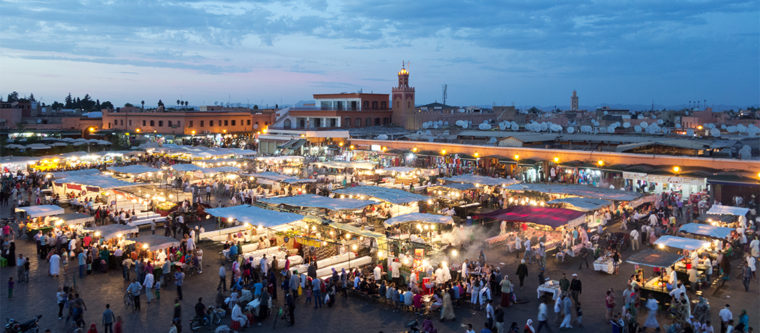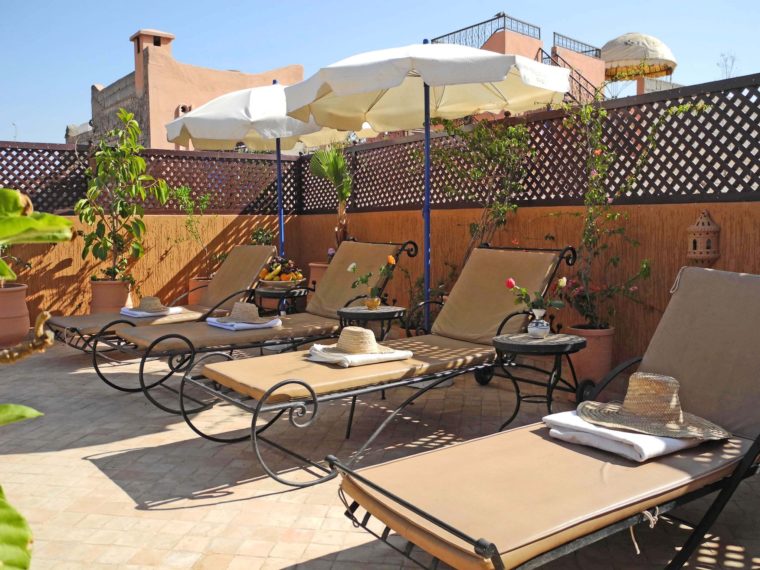Marrakech has always had a mystique about it. A city of immense beauty – low, red and tent like below the dramatic peaks of the High Atlas Mountains – its narrow alleys beg discovery whilst its bustling thoroughfares infuse the visitor with the city’s excitement and vitality. This is a vibrant, chic, cosmopolitan city that offers a wide range of cafes, restaurants, night-clubs, bars, shops, cultural events and art galleries attracting the rich and famous from Europe and beyond.
I am very fortunate to own a riad in this amazing city & have had many opportunities to visit over the years. Many of our guests often ask me what my favourites are so here are my top ten tips & also some hidden gems.
1. Stay in a riad if you want to experience the authentic Marrakech. Riads or maison d hotes are old restored houses in the medina that have renovated by mostly European owners to provide high quality guest houses. A riad means a house built round a patio gardens. Most riads are fairly small – about 6 bedrooms, beautifully decorated usually using local materials and local craftsmen but with all the modern comforts. You can be sure of a very personalized & friendly service. Many are English speaking and employ local Moroccan staff. Most riads will arrange to pick you up from the airport & most offer a range of services such as dinner in the riad, shopping trips, restaurant booking, day trips and excursions.
2. The Djemaa el Fna Square best visited when the light is turning to dusk This is where traditional music, dance, acrobats, storytelling, orange juice sellers, eating and socialising have continued unchanged for centuries & is a showcase of traditional Moroccan life. Grab a table on the terrace at one of the many cafes overlooking the square – enjoy a tagine /coffee / ice cream & watch all the action below. Also have a wander past the food stalls & listen to the waiters practice their English – ‘cheap as chips’ & ‘lovely jubilie’. However, this is not just a show put on for the tourists but where many Moroccan families come for the evening. If you are lucky you may also come across one of the traditional storytellers with a crowd around him. They are a vanishing breed. There is a fabulous book been written about them ‘The Last of the Storytellers’ by Richard Hamilton which is well worth reading. The Square has now been designated as a World Heritage site.

3. The Souks – these are the largest in North Africa & are great for wandering about in – you will get lost, but that’s all part of the fun & you will eventually make your way back out again. Yes, a lot of what is on display has been imported, however in tiny back alleys you will still see men hard at work cutting out slippers, turning wood, and creating many beautiful desirable objects. Bartering is a must and your riad will give you advice on what the going rate is for most items. A great stop off in the souks is the Café des Epices in the Spice Market Square. A seat outside or on the terrace is a great way to stop and watch the world go by with a nois-nois (half black, half white coffee).
4. The Koutoubia Mosque and its surrounding gardens is one of the city’s iconic historical sites, situated within view of the main square. Built during the 11th century, is the most perfect Islamic monument in North Africa. The minaret is especially stunning when lit up in the evenings.
5. The Marjorelle (Yves St Laurent) Gardens are exquisite gardens with cacti, bamboo groves, lily ponds and a stunning cobalt blue Art Deco pavilion. This twelve acre botanical garden was created in the 1920s and 1930s by French painter Jacques Marjorelle. It is now owned by the Yves St Laurent foundation. There is also a plaque to the designer and his ashes are buried here. Don’t miss the newly opened Museum of Islamic Art, a sumptuous collection of jewelry, clothing & artifacts from all over Morocco, beautifully displayed in gorgeous settings. There is also a lovely shop with many mementos to Yves St Laurent including his ever popular ‘love’ postcards. Lovely café if rather pricey.
6. The Bahia Palace – its name means ‘brilliance’ was originally built in 1866 – 67 for the then grand vizier (prime minister). Despite the presence of coach parties it is a beautiful place to wander around and admire all the faded beauty of its great courtyards, fragrant fruit trees and fountains. Take time to admire the halls to the east and the west decorated with fine zelliij fireplaces and painted wooden ceilings.
7. The El Badi Palace – you will know when you have come to the right place when you see the storks’ nests on the ramparts. This palace dates back to the sixteenth century and was built for the Sultan Ahmed el Mansour. Although now substantially in ruins you can still get a sense of why it name meant ‘the Incomparable’. South of the courtyard are the ruins of the palace stables. You may also recognise this from the film’ Rendition’ which stared Jake Gyllenhaal as many of the scenes were filmed in Marrakech.
8. Visit a Hammam – akin to a spa experience, cleansing in a hammam offers visitors an opportunity to refresh and dabble in a long-standing tradition. Many riads offer stylish, full-service hammams in-house. If your accommodation does not have one, ask the staff to recommend one from the many available throughout Marrakech’s neighbourhoods. After being steamed, scrubbed, cleansed, oiled and massaged you will emerge feeling very, rested, relaxed and clean. Allow at least 2hours and do not plan to do anything too energetic afterwards.
9. The Ben Youssef Madrasa, just north of the Musee de Marrakech is a 14th century religious school .The central courtyard with its beautiful pool featured in the film Hideously Kinky with Kate Winslet It was in use as a school until 1960 when it was closed. Visitor can admire the courtyard’s cedar carvings and also visit the dormitory quarters where over 600 boys lived.
10. The Musee de Marrakech This building was once a magnificent late nineteenth century palace built for defence minister Mehdi Mnebb (later Morocco’s ambassador in London). It had lain neglected for many years until it was finally restored and opened in 1997 as a museum to house exhibitions of Moroccan art and sculpture both traditional and modern. The building itself is beautiful. Don’t miss the inner courtyard with its huge brass lamp hung over a central fountain. The museum has also hosted many exhibitions from Vanessa Branson’s Biennale. There is a lovely café just inside the entrance which is open to everyone.
